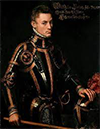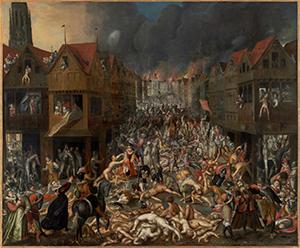William the Silent: Famous Dutch Statesman, Revolutionary
William the Silent was perhaps the most famous statesman and war leader in the early history of the Netherlands. He is also known as the first William of Orange. 
He was born on April 24, 1533, in Dillenburg Castle, in the County of Nassau-Dillenburg. His father was William, Count of Nassau, and his mother was Juliana of Stolberg-Wernigerode. He was his parents' oldest; they eventually had 11 other children. When young William was just 11, he came into a considerable fortune. His cousin, Renê Châlon, the Prince of Orange, died having no children as heirs; the prince's will stipulated that William should inherit the princely lands and titles. As was the case with many other sons of nobles, William served at the imperial court and was a ward of Charles V, who favored the young lad, sending him on diplomatic missions and even naming him captain of the cavalry when he was just 18. He also studied in several subjects, including foreign languages, under the tutelage of Mary of Hungary, who was Governor of the Habsburg Netherlands and a sister to the emperor, and under the well-known imperial advisor Nicolas Perrenot de Granvelle. William proved a very adept soldier and worked his way up the promotion ladder, achieving command of an imperial army in 1555. Charles sent William and his army to Bayonne to fight against the French and also named the young Dutchman to his Council of State. Four years later, the emperor named William governor of the Dutch provinces Holland, Utrecht, and Zeeland. He added to that responsibility the governorship of Franche-Comte two years after that. Despite this, William allied himself with a number of what the emperor would term dissidents, speaking out against Charles's favoritism of his native Spain at the expense of other parts of the Holy Roman Empire. 
It was on one of his early diplomatic missions that he earned his famous sobriquet. When France's King Henry II revealed to William a French plan to eliminate Protestantism from the Dutch provinces, William was inwardly shocked but outwardly stoic. He had no reaction at all, letting the French monarch think what he might about William's allegiance. This was the origin of the name William the Silent. At his father's urging and in order to fit in at court, William pursued the Catholic faith. However, William's father was no Catholic sympathizer himself (but, rather, a devout follower of Lutheranism), and his son found the religion not so much to his liking in the end. In fact, he professed to Calvinism, a leading Protestant sect, in the midst of the Dutch revolt. That revolt was an armed response to persecution by the forces of Emperor Charles, led by the then-Governor of the Netherlands, the Duke of Alba. Charles had, in 1555, handed over the ruling of the Netherlands to his son, King Philip II of Spain. Leading this movement along with William were Lamoral, Count of Egmont, and Philip de Montmorency, Count of Hoorn. Together, they rallied enough men of arms to take up weapons and fight back. It was a desperate struggle at first but gained strength and tenacity as the weeks, months, and years passed. Among the Duke of Alba's measures was to bypass Margaret of Parma, half-sister to King Philip II and the intended governor, and act as his own ruler, ordering reprisals and executions, including of powerful nobles, of anyone who opposed Philip and Catholicism. Among those executed were Lamoral and Montmorency. Protestant armies from both France and Germany invaded the Low Countries in 1568, in support of the resistance. William's forces, after suffering a defeat at Rheindalen in April of that year, enjoyed a significant victory at the Battle of Heiligerlee, in May, but the defenders found themselves outclassed and certainly outfunded by Philip and Alba. William of Orange left the country, and the repression continued. Historians generally regard that battle, Heiligerlee, as the start of what was later called the Eighty Years War. After a four-year period out of the sights of Alba and the Spanish, William of Orange was once more in the Low Countries, in Delft, directing the resistance. Spain was struggling with money problems at this time (and, indeed, throughout Philip's reign). At times, Spanish mercenaries went unpaid. One explosive reaction to this came in It turned out later that English ships had intercepted a large amount of money meant to pay the soldiers; but that made little difference to Philip, the soldiers themselves, or the aggrieved residents of Antwerp. The unity continued for a time. In 1579, three of the southern provinces signed the Union of Arras and agreed to ally with Philip. In response, William of Orange brought together five other provinces in the Union of Utrecht. As well, in 1581, the States General, a representative assembly originating with the creation of the Burgundian Netherlands a century before, formally ousted Philip II with the Act of Abjuration, replacing him as sovereign ruler with François, Duke of Anjou, whose older brother was France's Henry III. Even though Henry III was a Catholic monarch pursuing his own war against Protestants, the people of the northern Low Countries preferred an indirect link to Henry III to a direct link to Philip II. As it turned out, the trust given François was misplaced. He arrived in 1582, at the head of a small army, and within a few months tried to take Antwerp for himself. After revoking the offer of sovereignty, the States General tried to recruit Elizabeth I of England, but she demurred. The frustrated States General decided to do the governing themselves. Meanwhile, the Spanish forces had found rejuvenation under the Duke of Parma and reclaimed a large part of the Low Countries, including Breda, birthplace of William of Orange. It was at the Prinsenhof, William's home in Delft, that the famous statesman and war leader met his demise. A supporter of Philip II named Balthasar Gêrard, masquerading as a French nobleman, gained entry into William's home and shot him in the chest at close range. The shot was fatal. William had married, to Anna of Egmond, whose father was the influential Dutch nobleman Maximiliaan van Egmond. William and Anna married in 1551; they had three children. Anna died in 1558. William married again, in 1561; his new wife was Anna of Saxony; they had five children together. The second Anna had mental health problems, and the couple separated, in 1571. William's third wife was Charlotte de Bourtbon-Montpensier; they married in 1575 and had six children together. His fourth wife was Louise de Coligny; they married in 1583 and had a child together. William's oldest son, also named William, became Prince of Orange, beginning a hereditary succession that lasted for some time. His legacy is far-reaching:
|
|
Social Studies for Kids
copyright 2002–2026
David White



 November of 1576, when a group of Spanish soldiers who were part of the Army of Flanders turned their full frustration with the war and with their inability to get support or money on the city of Antwerp. For three days (Nov. 4–6), the troops sacked the city, at once the Low Countries' center of culture and finance. Deaths exceeded 7,000. Looting and destruction ensued on a large scale.
November of 1576, when a group of Spanish soldiers who were part of the Army of Flanders turned their full frustration with the war and with their inability to get support or money on the city of Antwerp. For three days (Nov. 4–6), the troops sacked the city, at once the Low Countries' center of culture and finance. Deaths exceeded 7,000. Looting and destruction ensued on a large scale.
